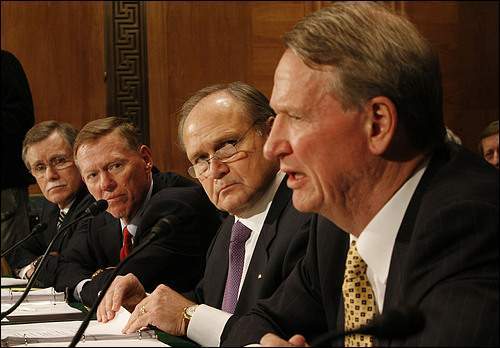Nardelli Wins The Iacocca Challenge
In testimony before the House Financial Services Committee, Chrysler CEO Bob Nardelli agreed to match Lee Iacocca’s $1 per year salary if Congress would only give his firm their $7b chunk of the proposed automaker bailout. Ford’s Alan Mulally told the Committee he is “fine where he is,” and noted that he needs to make sure his executive team is “well motivated,” given the fact that the company is so not of the woods its deep within them. As usual, the worst performance was put on by GM CEO Rick Wagoner, who claimed to have cut his own salary by 50 percent. Not that he was lying, he just conveniently forgot to mention that he had reinstated it. To make matters worse, he played the Curly card (“I’m a victim of coicumstance!”). Red Ink Rick complained that he’d purchased GM stock “with my own money” which was now “worthless.” I’m paraphrasing here– I can’t take notes while having my mind blown. The idea that a CEO would buy his own company’s stock, oversee its demise and then complain about the losses to Congress in an attempt to get bailout bucks for the company that he flew into the ground is… awesome. This is the guy who has overseen eight years of lost profit, lost market share and cratering market cap. A Gulfstream jet setter who’s refused to step aside as a theoretical condition of a theoretical bailout. Then again, who’s surprised?
Update: Wagoner’s direct quote was “I have a significant amount of General Motors stock, including a lot which I’ve bought myself, which basically is valueless. ” Hear that stockholders? That’s leadership. Hat tip to ABC Political Radar
More by Edward Niedermeyer


































Comments
Join the conversation
If Mullaly wants to motivate his executives, maybe he should set some goals to bring about long-term success at Ford. If you fail to meet your goals, you're fired. These guys have been claiming the need for high salaries (the carrot) to keep "good" people for far too long, maybe it's time to start handing out pink slips (the stick). As a side note, I don't think we should be paying for the travel expenses of any of our elected officials and certainly not for private jets. What ever happened to the idea of service to your country out of gratitude for what it provides you and out of a sense of responsibility towards your fellow man. I can only imagine how thick the slime trails were leading from the congressional hearings between the politicians and the car executives.
Shouldn't they maybe have considered driving to Washington? I would like to see Wagoner suffer through an 8 hour ride in any of GM's glorious Korean econo-boxes and still conclude that this is what the people wanted.
Its just stupid that the executives of the former big three are this tone deaf. If memory serves me correctly giving up the corporate jet was one of the symbolic gestures of Lee Iacocca in the early 80's bailout
psarhjinian: The Chevette came out in 1976. An Opel based design [T Car] sold in Brazil, Japan, Germany, etc. It couldn't compete with the Excel and Yugo as those two cars didn't come to the US until 10 or 12 years later. Even Car and Driver claimed it was the "most significant" car to ever come out of Detroit,[or something equally heavy handed]. The Monza was based on the VEGA and was meant to use the Mazda rotary built under license by GM. When that fell through, it was decided to shoehorn a v8 into the thing. So badly was it done the engine had to be dropped just to change the rear plugs. There is no way the Cavalier was worse. With a choice of bulky front heavy V8 or the Vega 4 or the Iron Duke ??? Buick and Pontiac versions got the V6.Olds could have the V8 or the Vega 4. L Later in the run [1983?] there was also the option of a Brazilian OHC 1.8 in the 2000 and later the Skyhawk and Firenza that was better suited to the J bodies. The Cavalier was shorter, had better interior room and gas mileage as well as a larger trunk [Monza trunk was about 6 cubic feet in the notch back] and, yes, better build quality. And though there were five J Body clones, at the least they were better differentiated than the H body [Monza] clones. The Monza was Motor Trend's Car of the Year for 1975 for what that was worth.But then so was the Vega for 1971. The Citation was Motor Trend's car of The Year for 1980. The Xs were an immense hit as they put full size room in a compact [Monza size] body. The Citation still holds the record for 1st year model sales at nearly 800,000 units. And as you mentioned held the record in recalls [until the Focus came along]. Had they been right from the beginning, those X's might have set the course for GM's future in a positive way instead of costing them untold #s of repeat customers. Vauxhall & Opel used the J Body and helped in it's development. They parted ways when GM wanted to develop an OHV engine for the US versions and IIRC the semi independent rear end. All well documented in Brock Yates book: "The Rise & And Fall Of The American Automobile". Say what you will about GM's misfires, you don't have to stray into exaggeration to find examples of poor product decision making over the past 30 years. They're low hanging fruit.